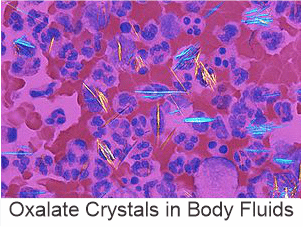Low Oxalates Foods May Help Reduce Auto-Immune Disease Risk, Autism and Fibromyalgia
Oxalate (or oxalic acid) is a compound found in a variety of plant-based foods. Under a microscope, oxalates are jagged in structure and look somewhat crystalline.
During metabolism, oxalic acid combines with other minerals like calcium, sodium, magnesium, and potassium to form compounds like calcium oxalate and sodium oxalate in the kidneys. This, in turn, may be responsible for mineral deficiencies.
One of the most common issues with increased oxalates in the urine (hyperoxaluria) is the formation of kidney stones. However, if the body struggles to eliminate oxalate, it can accumulate as crystals anywhere in the body. Commonly it accumulates in the blood, then the eyes, bones, skin, muscles, blood vessels, heart, and other organs.
High oxalates have also been linked with autism and inflammatory bowel disease. It can also be an underlying issue in those with ongoing gut problems or irritable bowel syndrome.
Tissue destruction, fibromyalgia, and autoimmune diseases such as rheumatoid arthritis and lupus are all issues that can be related to oxalates because oxalate in tissues triggers the inflammasome reactions of the body’s innate immune system.
As a side note, the thyroid will also suffer as oxalates can bind to T3 and disturb thyroid function.
The following list of vegetables should help identify foods high in oxalates:

As you can see from the list above, your favorite spinach (> 900 mg of oxalates) green smoothie may be contributing to a host of health issues!
Low oxalate diets involve eating less food that’s high in oxalates. Foods high in oxalates include certain types of fruits, vegetables, nuts, grains, and legumes.
On a low oxalate diet, you should limit your oxalate to 40 to 50 mg each day.
Summary
Whether for kidney stone prevention or to address other possible chronic health conditions, a low oxalate diet may be the solution.
On a low oxalate diet, you may notice a decreased risk of kidney stones, improved mineral absorption, diminished joint and muscle pain, improvement in fibromyalgia, autism symptoms, and autoimmune symptoms.
References:
The damaging effects of oxalates
Oxalate, inflammasome, kidney disease
How to eat a low oxalate diet/
Oxalates control in autism therapy
Pubmed – Pathogenic role in autism
Increased cardiovascular disease
Arterial plaque contains oxalate/
Tell Me How You’re Doing

Just write to me at PatientServices@AlternativeHealthAtlanta.com. I am concerned and very interested in your experience.
Wishing you the very best,
Dr. Billiot
Are you concerned about a specific health problem or problems?
Or, are you generally unhappy with the state of your health?
Blog Subscription
Get Great Information about your Health
- Weekly blog posts with vital tips and warnings
- Interesting “pass it along” health facts
- Cutting edge natural healing techniques and advice

Watch this video for a seven-minute explanation of how your body can be assisted to heal itself.

